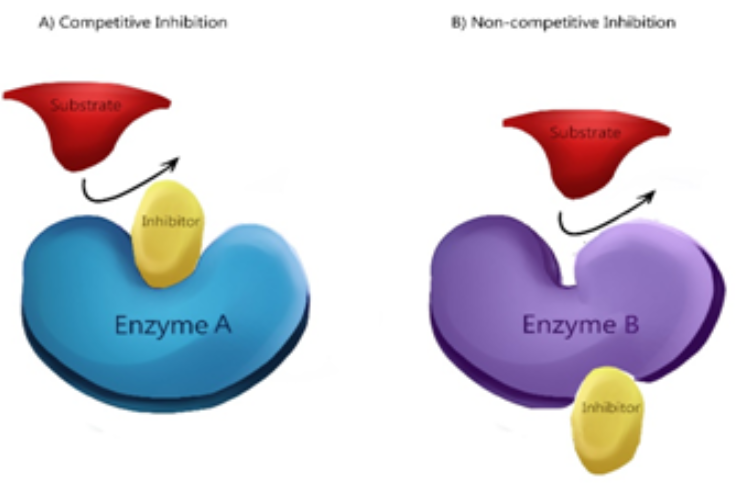
Which of the following statements regarding enzyme inhibition is correct?
A. Non-competitive inhibition of an enzyme can be overcome by adding a large amount of substrate.
B. Competitive inhibition is seen, when a substrate competes with an enzyme for binding to an
inhibitor protein.
C. Competitive inhibition is seen, when substrate and inhibitor compete for the active site on the
enzyme.
D. Non-competitive inhibitors often bind to the enzyme irreversibly.
Answer
559.5k+ views
Hint: Competitive inhibition is defined as the process by which one chemical substance inhibits the effect of another one by competing against it for the binding site. Enzyme inhibition is an example of competitive inhibition.
Complete answer: Competitive inhibition happens when the substrate and the inhibitor compete for the same active site. Here, the enzyme and the inhibitor have a similar structure. Thus, the inhibitor can get attached to the active site and inhibits the formation of the product. Active site only allows either the substrate or the inhibitor to bind to the enzyme. Increasing the concentration of the substrate molecule makes the chances of the substrate binding to the active site rather than the inhibitor.

Considering other options:
Non-competitive enzyme inhibition occurs when the inhibitor binds to a different site of an enzyme,
but unlike competitive inhibition is not affected by increasing the substrate concentration. In a competitive inhibition process, the substrate and the inhibitor are competing for the active site on the enzyme unlike competing for an inhibitor protein. Non- competitive inhibition is a reversible process, where a rapid dissociation of the enzyme-inhibitor complex. This process can be inhibited by increasing the concentration of substrate.
Thus, the correct answer is options C.
Note: Enzymes catalyze or change the rate of a reaction, i.e. they either decrease or increase the rate of a reaction. To maintain the optimum concentration, enzyme inhibition is very much required. The different types of enzyme inhibition are competitive, non-competitive and allosteric inhibition.
Complete answer: Competitive inhibition happens when the substrate and the inhibitor compete for the same active site. Here, the enzyme and the inhibitor have a similar structure. Thus, the inhibitor can get attached to the active site and inhibits the formation of the product. Active site only allows either the substrate or the inhibitor to bind to the enzyme. Increasing the concentration of the substrate molecule makes the chances of the substrate binding to the active site rather than the inhibitor.

Considering other options:
Non-competitive enzyme inhibition occurs when the inhibitor binds to a different site of an enzyme,
but unlike competitive inhibition is not affected by increasing the substrate concentration. In a competitive inhibition process, the substrate and the inhibitor are competing for the active site on the enzyme unlike competing for an inhibitor protein. Non- competitive inhibition is a reversible process, where a rapid dissociation of the enzyme-inhibitor complex. This process can be inhibited by increasing the concentration of substrate.
Thus, the correct answer is options C.
Note: Enzymes catalyze or change the rate of a reaction, i.e. they either decrease or increase the rate of a reaction. To maintain the optimum concentration, enzyme inhibition is very much required. The different types of enzyme inhibition are competitive, non-competitive and allosteric inhibition.
Recently Updated Pages
Why are manures considered better than fertilizers class 11 biology CBSE

Find the coordinates of the midpoint of the line segment class 11 maths CBSE

Distinguish between static friction limiting friction class 11 physics CBSE

The Chairman of the constituent Assembly was A Jawaharlal class 11 social science CBSE

The first National Commission on Labour NCL submitted class 11 social science CBSE

Number of all subshell of n + l 7 is A 4 B 5 C 6 D class 11 chemistry CBSE

Trending doubts
10 examples of friction in our daily life

One Metric ton is equal to kg A 10000 B 1000 C 100 class 11 physics CBSE

Difference Between Prokaryotic Cells and Eukaryotic Cells

1 Quintal is equal to a 110 kg b 10 kg c 100kg d 1000 class 11 physics CBSE

State the laws of reflection of light

Explain zero factorial class 11 maths CBSE




